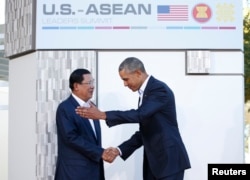On the thorny issue of Southeast Asia’s territorial disputes in the South China Sea, Cambodia finds itself caught in the middle.
On one side, its fellow members of the Association of Southeast Asian Nations (ASEAN) say the regional bloc should be central to dealing with the disputes. On the other, China—the world’s most populous nation and second biggest economy, and the largest source of investment and aid for Cambodia—wants to deal with each counter-claimant bilaterally, without regional or international mediation.
In February, Prime Minister Hun Sen traveled to the United States—his first official visit to the country during more than 30 years in power—to attend the so-called Sunnylands Summit, an unprecedented meeting of Southeast Asian and American leaders seen as an attempt by the U.S. to counter China’s increasingly assertive moves in the region.
Hun Sen at the meeting supported a joint declaration that includes clear references to the maritime disputes, and espouses the concept of “ASEAN Centrality.”
But the Cambodian government had been accused of kowtowing to China since it scuppered a joint communiqué when it chaired ASEAN for the second time in 2012.
Since Sunnylands, China has made its own diplomatic efforts on the maritime rows. Foreign Minister Wang Yi, on an April 20-24 tour of Brunei, Cambodia and Laos secured a “consensus” with those nations that disputes were not a matter for ASEAN. The maritime rows should be “resolved through dialogues and consultations by parties directly concerned,” the official website of the Chinese Ministry of Foreign Affairs said.
The “consensus” announcement was also timed ahead of an imminent ruling on the Philippines’ petition to the Permanent Court of Arbitration in the Hague over its territorial dispute with China. “China does not want to have anything to do with the Philippines’ case against China,” said Pou Sothirak, a former diplomat and executive director of the Cambodian Institute for Cooperation and Peace. China has said it will ignore the court’s ruling.
China has been consistent on the issue of its maritime territorial disputes, Pou Southirak said by email, explaining that China’s position was that it would resolve matters with Brunei, Malaysia, the Philippines and Vietnam bilaterally, but not with ASEAN as a whole. Nor does China want any international mechanisms or other powers like the U.S., its geopolitical rival, involved.
“The agreement [with Brunei, Cambodia and Laos] should be treated as part of a Chinese diplomatic attempt to gain support from some ASEAN member states to conform with the four-point consensus,” he said.
Others in the region have reacted angrily to what they see as China using smaller nations—whose economies are bolstered by Chinese investment—to undermine regional unity. Those ASEAN members who dispute parts of the sea and its islands with China believe the regional grouping gives them a louder voice with which to oppose China’s claims.
“Any consensus between China and the aforementioned three countries further divides ASEAN and benefits China,” said Paul Chambers, director of research at the Institute of Southeast Asia Affairs in Chiang Mai, Thailand.
Ong Keng Yong, a Singaporean diplomat and ASEAN’s secretary-general between 2003 and 2007, said China’s latest move amounted to interfering with other states’ affairs, and threatened unity among ASEAN countries. It was “very surprising” that non-claimant ASEAN nations Cambodia and Laos would agree to the consensus announced by China, he said, according to Channel News Asia.
In response, Sim Vireak, a former Cambodian diplomat to Japan, wrote to the Phnom Penh Post newspaper on April 29 saying Ong’s remarks were “strange,” and “disrespectful” to Cambodian sovereignty. In its capacity as a non-claimant state, Cambodia, said Sim Vireak, has always maintained a neutral position on the South China Sea.
Kung Phoak, co-founder and president of the Cambodian Institute for Strategic Studies, said Cambodia’s approach to the issue was in keeping with the core ASEAN principles of respecting sovereignty and maintaining peace.
Signing up to China’s consensus should not be interpreted as showing Cambodia’s bias toward China, Kung Phoak said, dismissing the notion that the two countries’ close economic ties and the formal “Comprehensive Strategic Partnership of Cooperation” had any influence on the decision.
“Cambodia’s decision is based on critical thinking on all factors not based on one country’s influence,” he said. “Cambodia needs to balance interests with other partner countries not just China.”
Kung Phoak continued that the bloc’s claimant states want a solution mediated by ASEAN, but given its central principle of non-interference, its role will be limited to facilitating negotiation between antagonists.
“ASEAN does not have the ability to decide on behalf of the disputed countries,” he said, pointing, for historic precedent, to the role ASEAN played when Cambodia and Thailand faced off over the Preah Vihear temple and surrounding areas on their shared border.
“The conflict between the two countries [Cambodia and Thailand] impacts the whole ASEAN interest. What ASEAN could do back then was to encourage the two parties to sit on the negotiation table to resolve the conflict peacefully, pursuant to the international laws. Indonesia requested to send peace-keeping troop to the disputed areas; Thailand rejected that request.”
Whether or not Cambodia’s actions are unduly influence by China, Kosal Path, an assistant professor of political science at Brooklyn College in New York, pointed out it is not the only ASEAN country with a powerful patron when it comes to national security.
“Vietnam and the Philippines have increasingly relied on a bilateral alliance or strategic security partnership as a hedge against China,” said Kosal Path by email, seeming to refer to those countries’ military ties with the U.S.














